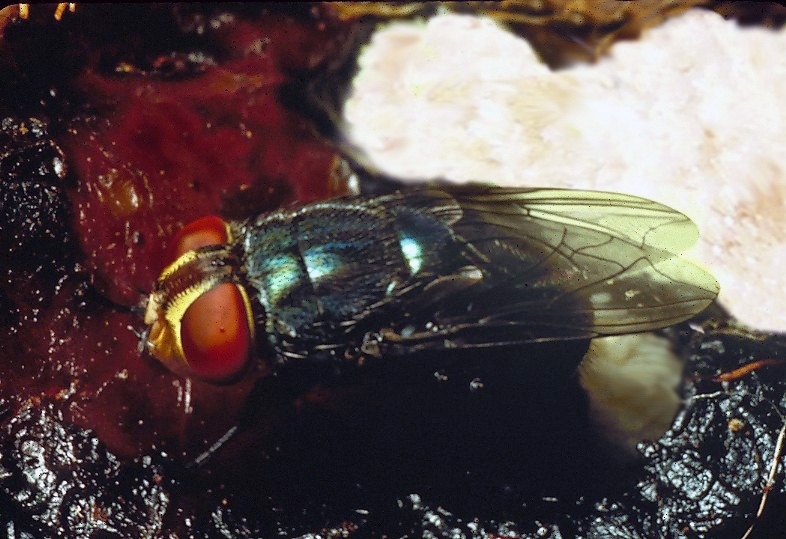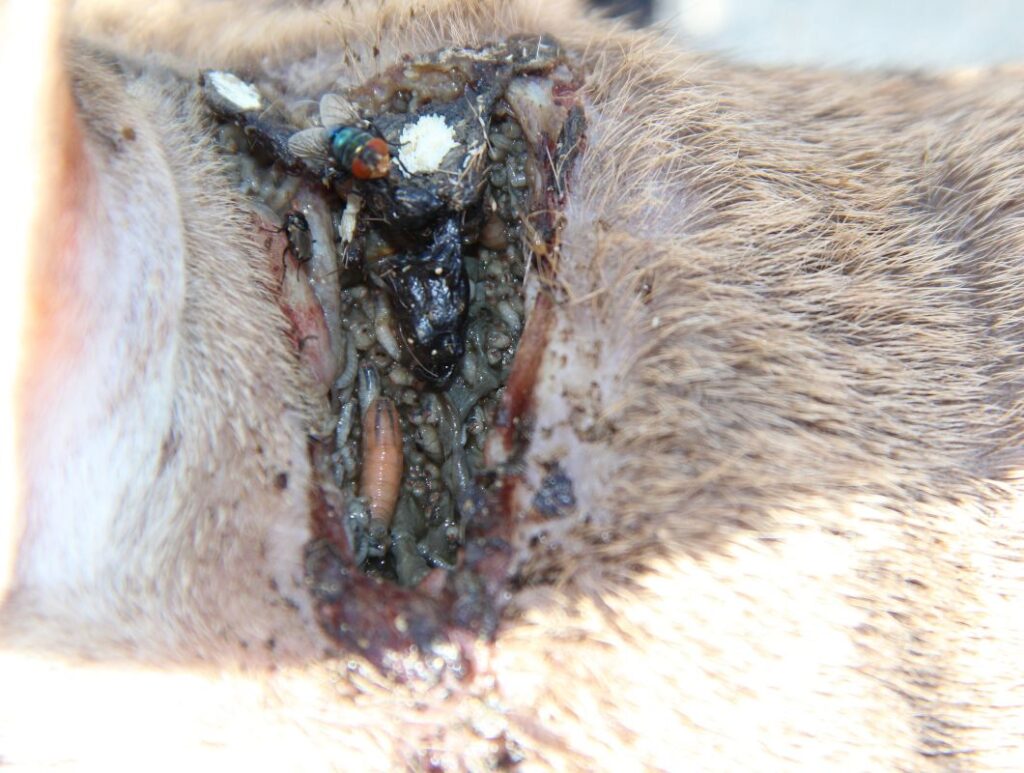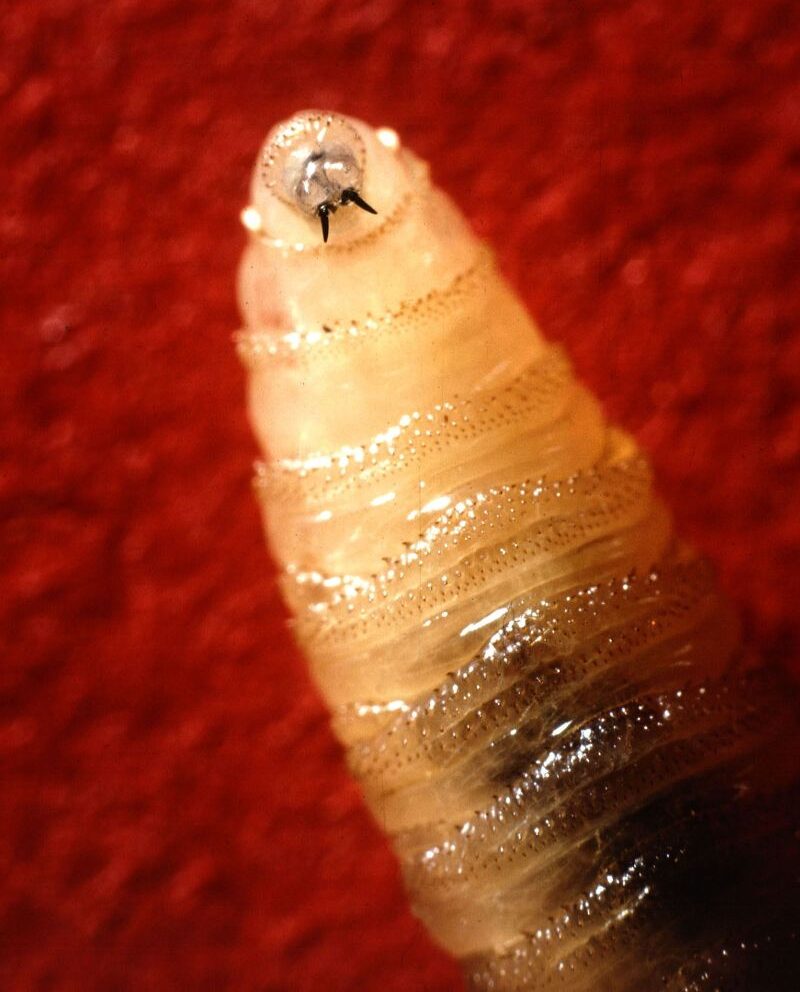
Regularly Inspect Animals for Signs of the Pest Detected in Mexico and Central America
KNOXVILLE, Tenn. – The New World screwworm is back in the news this week as a traveler to an infested area was parasitized and returned to the United States. While the U.S. Department of Agriculture is leading efforts to keep the New World screwworm out of the country, University of Tennessee Institute of Agriculture entomologists recommend farmers and residents remain vigilant and proactive in monitoring livestock for the pest.
The New World screwworm (NWS) is a species of blow fly so named because its larval stage, a maggot, uses sharp mouth hooks to burrow into the host like a screw twisting into wood. The females lay eggs in warm-blooded animals in open wounds such as cuts, scrapes, tick bites and incisions caused by castration, dehorning and branding. Young animals are especially susceptible to NWS. The larvae will infest the belly button and umbilical cords of newborn animals such as calves, ewes and foals. The eggs hatch and the larvae feed on the living tissue, enlarging the wound and ultimately causing death. Animals at risk include livestock, pets, wildlife and even humans. No livestock cases have been recorded in Tennessee or the United States so far this year.

“Even though NWS has not been found in the U.S., it is important to understand the potential impacts of this pest and familiarize yourself with the signs of NWS infestations. Preventing accidental introductions is key to keeping this pest out of the U.S., and early detection is crucial for treatment and containment efforts,” said Katy Smith, veterinary entomology education specialist with the UT Department of Entomology and Plant Pathology.
UT Extension recently posted publication W1338 “Species Highlight: New World Screwworm” that provides background information, facts about the pest and ways to protect livestock, pets and yourself. Smith and Becky Trout Fryxell, professor and UT entomologist specializing in Medical and Veterinary Entomology, wrote the publication.
The recent human case in the news was a Maryland resident who traveled to El Salvador, according to the U.S. Department of Health and Human Services.
NWS is a tropical species that cannot overwinter in temperate areas such as Tennessee. Endemic to many Caribbean islands and South America, NWS found its way to the United States in the 1830s in Texas. In the 1930s and 40s, U.S. livestock producers annually lost an estimated $10 million to $20 million from cattle infestations. An effective control method of releasing sterile, lab-raised males to mate with fertile wild females helped reduce the population, and it was declared eradicated in the United States in 1966. A biological barrier was put into place in eastern Panama through the Panama-United States Commission for the Eradication and Prevention of Screwworm in 2006. However, there was an outbreak in the Florida Keys in 2016 that mostly impacted the Key deer population. The fly breached the barrier in 2023, and it has since spread north to Mexico. The USDA announced plans in June to prevent spread into the U.S. with several measures including restarting dispersal of sterile male flies and surveillance of cattle crossing from Mexico into the U.S.

NWS is not to be confused with a similar species commonly found in the U.S., the secondary screwworm. Unlike NWS, secondary screwworm larvae typically infest wounds or tissues that are already dead, and they are considered beneficial decomposers. Secondary screwworm larvae are smaller than NWS and have less pronounced mouth hooks. Although secondary screwworms do not pose a threat to livestock and wildlife, they can appear similar to NWS, and so any sighting of a suspected screwworm should be reported to state or federal officials.
Farmers and residents can protect their livestock, pets and themselves by following these measures:
- Monitor livestock by regularly inspecting for signs of infestation such as unexplained wounds, maggots in wounds, foul odors or behavioral changes. NWS can burrow deep into a small wound.
- Treat wounds promptly.
- Purchase animals from reputable sources and always quarantine new animals.
- Travel cautiously. If traveling internationally with pets, ensure they are inspected. If you are in an NWS-infested area, check your vehicle for screwworm flies.
- Stay informed. The USDA and Tennessee Department of Agriculture will provide updates if the situation changes.
If you think you have found a screwworm, report it immediately to your state animal health official (Tennessee State Veterinarian at 615-837-5120 or the USDA Area Veterinarians in Charge at 615-517-2642). On weekends and evenings, please contact 866-536-7593. Suspicious cases will be evaluated, and samples may be submitted to the laboratory for confirmation. The Tennessee Department of Agriculture Animal Health Division will assist veterinarians with sample collection and submission.
For more information, refer to UT Extension publication W1338.
The University of Tennessee Institute of Agriculture is comprised of the Herbert College of Agriculture, UT College of Veterinary Medicine, UT AgResearch, and UT Extension. Through its land-grant mission of teaching, research and outreach, the Institute touches lives and provides Real. Life. Solutions. to Tennesseans and beyond. utia.tennessee.edu.